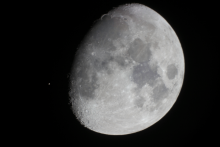Listen to today's episode of StarDate on the web the same day it airs in high-quality streaming audio without any extra ads or announcements. Choose a $8 one-month pass, or listen every day for a year for just $30.
You are here
Moon and Aldebaran
The Moon and the bright star Aldebaran are scheduled for a last rendezvous tomorrow night. The Moon will pass in front of the bright star, briefly blocking it from view. It’s the last time they’ll meet that way until 2033.
Such an encounter is known as an occultation. And the Moon and Aldebaran began a series of them in January of 2015.
Occultations between the two bodies are possible because of their positions relative to the ecliptic, which is the Sun’s path across the sky. Aldebaran — the bright orange eye of Taurus, the bull — is about five and a half degrees south of the ecliptic. The Moon, on the other hand, moves back and forth across that path. At its maximum extent south of the ecliptic, it just overlaps Aldebaran.
That doesn’t happen every time the Moon passes Aldebaran. Instead, the occultations occur over a period of about three and a half years, with the middle of any two cycles separated by 18.6 years. So the next cycle begins in 2033 and ends in 2037. And because of the viewing angle, occultations of Aldebaran are visible only from the northern hemisphere.
This occultation will be visible from some of the islands of far-northern Canada and a bit of Greenland. Here in the United States, we’ll have to settle for a close pairing of the two bodies. Aldebaran will stand to the lower left of the Moon at first light tomorrow, and even closer to the upper right of the Moon on Monday.
Script by Damond Benningfield




